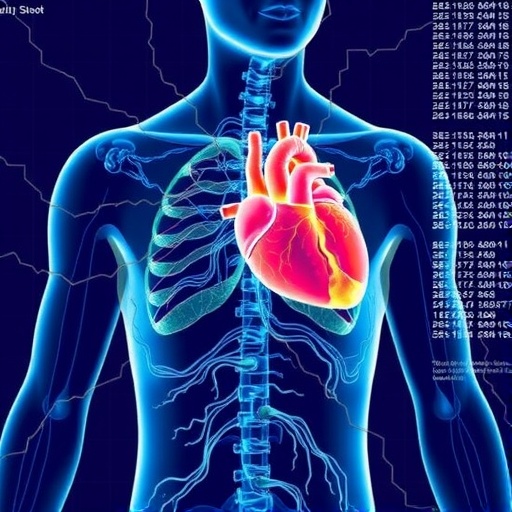
In a groundbreaking study published in Nature Communications, the MULTI consortium, led by Anagnostakis, F. and Ko, S., has unveiled a novel framework for understanding biological aging through the lens of the multi-organ metabolome. This innovative research elucidates the intricate metabolic changes occurring across various human organs, thereby shedding light on the fundamental biological processes that underlie aging and its association with cardiometabolic diseases and mortality risk. The findings pivotally challenge and extend current aging models by moving beyond single-tissue analyses to a comprehensive, multi-organ approach that integrates systemic metabolic profiles.
Biological age, distinct from chronological age, serves as a pivotal biomarker that more accurately reflects the physiological condition and health trajectory of an individual. Traditionally, biological age estimations have often relied on epigenetic clocks or singular biomarkers isolated within specific tissues or blood samples. However, this new metabolomic approach considers the coordinated metabolic shifts across multiple vital organs, providing a more robust metric that captures the complexity of aging as a multisystem phenomenon.
The multi-organ metabolome paradigm rests on the systematic profiling of metabolites—small molecules that represent the end products and intermediates of cellular metabolism—across the liver, heart, kidneys, skeletal muscle, and brain, among others. By employing advanced mass spectrometry and nuclear magnetic resonance spectroscopy techniques, the consortium was able to quantify thousands of metabolites, painting a detailed map of metabolic fluxes and disruptions that correspond with varying biological ages. This integrative analysis reveals specific metabolic signatures emblematic of accelerated aging and preclinical cardiac and metabolic dysfunction.
One of the most compelling revelations from this study is the identification of a metabolomic signature that not only correlates strongly with cardiometabolic disease states but also predicts mortality risk independently of traditional risk factors such as blood pressure, cholesterol levels, or body mass index. This implicates that biological age, as measured through metabolomic profiles, might serve as a more sensitive and earlier biomarker for intervention to prevent fatal outcomes associated with cardiometabolic conditions.
From a mechanistic perspective, the alterations in branched-chain amino acid metabolism, lipid oxidation pathways, and nucleotide turnover emerged as central processes affected in aging organs. These metabolic derangements reflect cellular senescence, mitochondrial dysfunction, and heightened oxidative stress, hallmarks well-known to contribute to aging-related tissue deterioration. Furthermore, the metabolic interplay between organs suggests a systemic network failure rather than isolated damage, implicating a need for holistic treatment approaches.
Of particular note is how the consortium’s multi-organ approach captures heterogeneity in biological aging that is often masked in blood-based or single-organ studies. Individuals exhibiting similar chronological ages displayed significant differences in their metabolic profiles across distinct organs, highlighting personalized aging trajectories. This discovery opens up potential for precision medicine strategies targeting organ-specific aging pathologies, tailored to individual metabolic landscapes.
The technical rigor of the study cannot be overstated. The integration of high-dimensional metabolomic datasets with sophisticated machine learning algorithms facilitated the construction of a biological aging clock firmly grounded in multi-organ metabolic states. The model outperformed existing biomarkers in predicting adverse clinical outcomes, setting a new standard in the field for biomarker development. Such computational approaches underscore the transformative role of artificial intelligence in unraveling biological complexity.
Importantly, the consortium extended their analyses to diverse population cohorts, demonstrating the robustness and generalizability of the metabolomic age signatures across ethnicities and lifestyle variables. This ensures the translational viability of the findings, with the possibility of universal application in clinical practice. The researchers stress that measuring multi-organ metabolomes could become a routine yet powerful tool in preventive cardiology and geriatric medicine.
These advancements hold profound implications for early diagnosis and therapeutic interventions. By pinpointing metabolic dysfunctions before overt organ damage or disease manifestation, clinicians could deploy interventions to restore metabolic homeostasis and slow biological aging. Lifestyle modifications, pharmacological agents targeting metabolic enzymes, or emerging metabolome-modifying therapies might be employed more precisely based on an individual’s metabolic age profile.
Moreover, the study provides a framework for monitoring the efficacy of anti-aging interventions in clinical trials. Traditional endpoints such as chronological age or single biomarker levels lack sufficient sensitivity, whereas the multi-organ metabolome clock offers a dynamic and responsive metric. This could accelerate the development pipeline for geroprotective drugs and personalized intervention strategies, ultimately extending healthspan.
While the findings are promising, the authors acknowledge challenges ahead. The invasive nature of sampling multiple tissues remains a barrier. However, advancements in imaging metabolomics and minimally invasive biopsy techniques are rapidly emerging fields that may soon overcome these limitations, making multi-organ metabolic profiling accessible at scale.
In conclusion, the work by the MULTI consortium marks a paradigm shift in aging research by placing the metabolome at the heart of biological age estimation. The demonstrated link to cardiometabolic health and mortality underscores the clinical importance of adopting metabolic biomarkers in routine health assessments. As research continues to unravel the molecular underpinnings of aging, such integrative, system-wide approaches will be indispensable in designing next-generation diagnostics and therapeutics.
This innovative synthesis of metabolomics and aging biology paves the way for a future where the devastating burden of age-related diseases could be mitigated through early detection and targeted metabolic interventions. Such advances bring us closer to the aspirational goal of not just extending lifespan but enhancing the quality of life and functional longevity for populations worldwide.
Subject of Research: Biological aging estimation through multi-organ metabolome profiling and its relationship with cardiometabolic conditions and mortality risk.
Article Title: Multi-organ metabolome biological age implicates cardiometabolic conditions and mortality risk.
Article References:
The MULTI consortium., Anagnostakis, F., Ko, S. et al. Multi-organ metabolome biological age implicates cardiometabolic conditions and mortality risk. Nat Commun 16, 4871 (2025). https://doi.org/10.1038/s41467-025-59964-z
Image Credits: AI Generated
Tags: advanced mass spectrometry applicationsaging biomarkersbiological aging researchcardiometabolic disease connectioninnovative aging modelsliver heart kidney muscle brain metabolitesmetabolic profiling techniquesmulti-organ health integrationmulti-organ metabolomemulti-tissue metabolic analysisphysiological health trajectorysystemic health assessment



